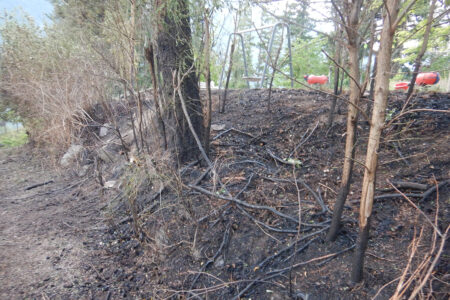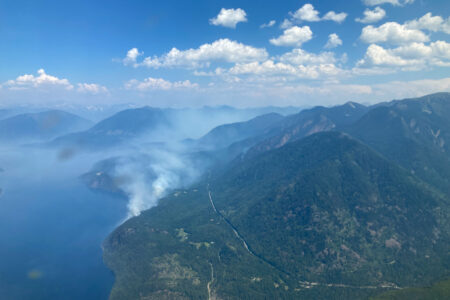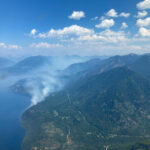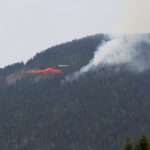Illegal tent practices and ‘anti-social behaviours’ subject of proposed city legislation
In an effort to mitigate some of the growing problems with “anti-social behaviours” seen in parks and public spaces in Grand Forks the city is now considering legislation to deal with persistent temporary shelters in public spaces.
A proposed amendment bylaw on park access passed three readings on Sept. 5 in Grand Forks city council chambers, with final adoption set to come Sept. 18.
The current city Parks Access Bylaw regulates public parks, public trails, beaches and boulevards in the city, stating that no “person shall set up or occupy any camper, trailer, or other form of temporary shelter, on or within any park.”
That section will be struck and replaced with “no person shall place, secure, erect, use or maintain a temporary shelter on any public place or park within the city: (a) between 9 a.m. and 7 p.m.”
As well, any shelter found to be placed, secured, erected, used or maintained between the hours of 9 a.m. and 7 p.m. on any public place or park within the city will be subject to enforcement and removal — including any possessions, wastes and other incidental materials.
The amendment also pertains to playgrounds, spray parks, skateboard parks, tennis courts or other sports courts, sports fields, stadiums or dugouts, stages or bleachers, washroom facilities, picnic shelters, or gazebos, cemeteries, or bridges within the city.
When council met Sept. 5, Coun. Colleen Ross asked city staff why there was a specific time contained in the bylaw.
“Sometimes families will go in (to parks) or persons that are picnicking for the day and they want to set up a shelter for the day … so that could make it tricky,” she said.
The times outlined in the bylaw are what are used in other communities, replied city manager of development and engineering, Dolores Sheets, and they have been through a legal process in determining this.
“Does that mean after 7 p.m. people can go in and set up shelters?” asked Ross.
“You have to provide a place for them to be. If you cannot provide housing for them you have to allow them to be somewhere,” Sheets said. “This has been proven in the courts.”
There had been a discussion for a time earlier than 9 a.m. and wondered if it should be moved back in some areas and at some facilities, she added.
Ross wondered why there was a timeframe at all.
The city was not able to create a blanket ban for tenting in all areas of the city, said city senior engineer Graham Watt, due to a successful human rights challenge in the Lower Mainland.
He said the city had to accommodate having some city space for tents or temporary shelters in order to have areas where it was just not okay to have tents.
Coun. Beverley Tripp had concerns about the 7 p.m. start time.
“A lot of people are still out and walking their dogs and doing stuff in the parks after 7 p.m. and I just wondered if 7 p.m. would be on the early side?” she said.
The times were battle tested after being vetted through a lot of legal counsel, said Watt, and the city would have to consult its own legal counsel if it wanted to change it.
“The public lands around town are essentially everything within the city limit. As a blanket bylaw it covers everything, not just what we would consider as publicly maintained lands, but all of the roadways, boulevards and trails,” he said.
By having the blanket bylaw and having it “loose,” it sets the foundation for specifics in other areas of the bylaw, Watt explained.
Coun. Julia Butler wondered if there would be a provision and penalty for repeat offenders if they have to be removed every day.
“It would be sort of a three strikes you are out. Legally can we do that?” she asked.
“We would have to look into that, but legally it would be difficult. We would have to consult with the RCMP,” said Watt.
One member of the audience asked council what it would be doing about the tents along the riverbank, the major problem area in the city.
City chief administrative officer Diane Heinrich said the riverbank was “kind of a grey area” because it was Crown land and it was within the municipality.
The city has had some discussions with the province on where it could go with that question, she said, and what the courts might allow.
“There has to be some partnership with the province and see exactly what we can or can’t do and we have to be sure as far as legal advice on that,” she said.
The current bylaw sets out fines as the penalty for not following the regulations, read a city staff report to council.
Because financial penalties are not effective to persons not owning real estate within the city, the report noted, it was proposed to insert section 22.1 as follows:
22.1 Where an bylaw enforcement officer or any other officer of the city has reasonable grounds to believe that a person, while in a park or public space, is in contravention of any provision of this bylaw the officer may:
(a) direct the person to comply with the bylaw; or
(b) direct the person to leave the park or public place.
i. A person who is directed to leave the park or public place must immediately leave the park or public place and refrain from re-entering for a period of 24 hours or until 7 p.m. the following day whichever is longer.
A member of the council gallery asked how council would even be able to enforce the bylaw, considering the people who might cross it do not own property.
“I believe we have to start somewhere and this bylaw would give the bylaw officers something to work with,” said Heinrich. “At least it’s a start and we can modify things as we move along.”
“This isn’t perfect but at least it is a deterrent,” added Butler.






















